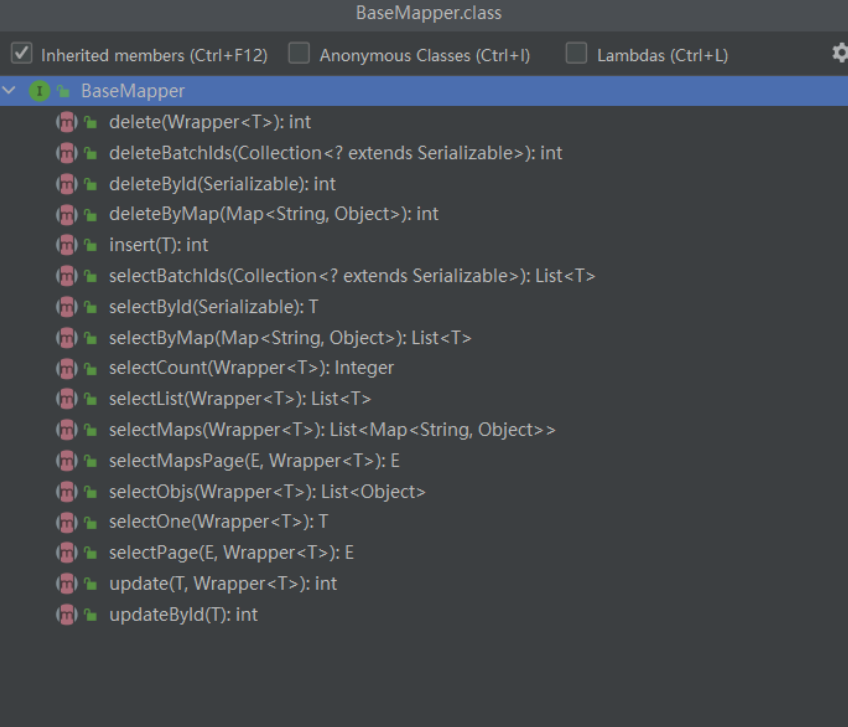MyBatis-Plus(三、增删改查)
- 2022 年 9 月 17 日 河南
本文字数:3442 字
阅读完需:约 11 分钟

前言
MyBatis 非常方便,代码简洁,开发速度极高,通过继承 BaseMapper 就可以获取到各种各样的单表操作,无需再写其他的接口方法,非常的简便快捷。
我们可以看到 BaseMapper 为我们提供了很多方法供我们 CRUD 使用。

Mapper CRUD 接口
说明:
通用 CRUD 封装[BaseMapper 接口,为 Mybatis-Plus 启动时自动解析实体表关系映射转换为 Mybatis 内部对象注入容器
泛型 T 为任意实体对象
参数 Serializable 为任意类型主键 Mybatis-Plus 不推荐使用复合主键约定每一张表都有自己的唯一 id 主键
对象 Wrapper 为 条件构造器
1、查询
1、查询所有,不加条件去查询
//1、查询所有,不加条件去查询userMapper.selectList(null).forEach(System.out::println); //forEach遍历打印
2、查询所有,加条件去查询
//2、查询所有,加条件去查询 //2.1、new QueryWrapper QueryWrapper queryWrapper1 = new QueryWrapper(); //2.2、设置条件 queryWrapper1.eq("age", 20); userMapper.selectList(queryWrapper1).forEach(System.out::println);
lt #小于
gt #大于
ne #不等于
eq #等于
le #小于等于
ge #大于等于
等等
3、多条件去查询
new 一个 hashmap,把条件放到 map 中,再把 map 放到条件中。
QueryWrapper queryWrapper2 = new QueryWrapper(); //3.1、设置多条件 Map<String,Object> map = new HashMap<>(); map.put("age",20); map.put("name","张三"); //3.2、map放进queryWrapper queryWrapper2.allEq(map);
4、分页查询
//4、分页查询 //1、配置类paginationInterceptor //2、设置分页参数 Page<User> page = new Page<>(1,3); //当前页,每页显示条数2 Page<User> userPage = userMapper.selectPage(page, null);//分页参数,查询条件
System.out.println(userPage.getCurrent()); //当前页 System.out.println(userPage.getSize()); //每页显示条数
userPage.getRecords().forEach(System.out::println); //查询结果
5、等等
@Test void select() { //1、查询所有,不加条件去查询 userMapper.selectList(null).forEach(System.out::println); //forEach遍历打印
//2、查询所有,加条件去查询 //2.1、new QueryWrapper QueryWrapper queryWrapper1 = new QueryWrapper(); //2.2、设置条件 queryWrapper1.eq("age", 20); /** * lt #小于 * gt #大于 * ne #不等于 * eq #等于 * le #小于等于 * ge #大于等于 * between #between * like like 模糊查询 #likeLeft 左模糊 likeRight 右模糊 * isNull * isNotNull * in #inSql in sql语句 * notIn * orderBy #排序 ASC DESC 升序降序 * orderByDesc */ userMapper.selectList(queryWrapper1).forEach(System.out::println);
//3、多条件去查询 QueryWrapper queryWrapper2 = new QueryWrapper(); //3.1、设置多条件 Map<String,Object> map = new HashMap<>(); map.put("age",20); map.put("name","张三"); //3.2、map放进queryWrapper queryWrapper2.allEq(map);
//byId User user = userMapper.selectById(1); System.out.println(user);
//byBatchIds userMapper.selectBatchIds(Arrays.asList(1,2,3)).forEach(System.out::println); //Arrays.asList(1,2,3)是一个数组,把数组转换成list集合
//通过map条件查询 //map只能是一个条件,不能是多个条件 Map<String,Object> map1 = new HashMap<>(); map1.put("age",20); map1.put("name","张三"); userMapper.selectByMap(map).forEach(System.out::println);
//4、分组查询 QueryWrapper queryWrapper3 = new QueryWrapper(); queryWrapper3.gt("age",20); System.out.println(userMapper.selectCount(queryWrapper3));
//将查询结果放入map中 userMapper.selectMaps(queryWrapper1).forEach(System.out::println);
//分页查询 //1、配置类paginationInterceptor //2、设置分页参数 Page<User> page = new Page<>(1,3); //当前页,每页显示条数2 Page<User> userPage = userMapper.selectPage(page, null);//分页参数,查询条件
System.out.println(userPage.getCurrent()); //当前页 System.out.println(userPage.getSize()); //每页显示条数
userPage.getRecords().forEach(System.out::println); //查询结果
//封装到map中 Page<Map<String,Object>> mapPage = new Page<>(1,3); //分页参数,查询条件 userMapper.selectMapsPage(mapPage, null).getRecords().forEach(System.out::println); //查询结果
//查询所有,只输出id userMapper.selectObjs(null).forEach(System.out::println); //查询结果
//查询一个 System.out.println(userMapper.selectOne(null)); //查询结果
}
2、添加
/** * Insert */ @Test void insertTest(){ User user = new User(); user.setName("张三"); user.setAge(20); userMapper.insert(user); System.out.println(user); }
3、删除
/** * Delete */ @Test void deleteTest(){ //通过id删除 userMapper.deleteById(1);
//通过多条件id删除 userMapper.deleteBatchIds(Arrays.asList(1,2,3));
//通过条件删除 QueryWrapper queryWrapper = new QueryWrapper (); queryWrapper.eq("name","张三"); //与查询相同 userMapper.delete(queryWrapper);
//通过条件删除---Map Map<String,Object> map = new HashMap<>(); map.put("name","张三"); userMapper.deleteByMap(map);
}
4、修改
/** * Update */ @Test void updateTest(){
//通过id更新 User user = userMapper.selectById(1); //查询数据 user.setName("李四"); //修改数据 user.setAge(30); userMapper.updateById(user);
//通过QueryWrapper更新 User user1 = userMapper.selectById(1); //查询数据 QueryWrapper queryWrapper = new QueryWrapper(); //构建条件 queryWrapper.eq("name","张三"); queryWrapper.eq("age",20); userMapper.update(user1,queryWrapper); //更新数据
}
5、自定义 SQL(多表关联查询)
当我们需要多表查询时,简单的 crud 满足不了我们的需求时,我们就需要通过自定义 sql,来实现我们的所需的功能。
package com.southwind.mybatisplus.mapper;
import com.baomidou.mybatisplus.core.mapper.BaseMapper;import com.southwind.mybatisplus.entity.ProductVO;import com.southwind.mybatisplus.entity.User;import org.apache.ibatis.annotations.Select;
import java.util.List;
public interface UserMapper extends BaseMapper<User> { @Select("select p.*,u.name userName from product p,user u where p.user_id = u.id and u.id = #{id}") List<ProductVO> productList(Integer id);}
总结
Mybatis 为我们提供了基本的增删改查的接口,特别是 Mybatis-Plus 提供的 Wrappers 更是可以组合出更复杂的查询语句以满足我们需求。但有些复杂的操作,比如联表查询等,这些就需要使用自定义 SQL 语句进行操作的。
版权声明: 本文为 InfoQ 作者【斯】的原创文章。
原文链接:【http://xie.infoq.cn/article/b5fd5b6ebd530cb7c3cbef2a7】。文章转载请联系作者。
斯
在校大三学生一枚 2022.08.02 加入
喜欢学习编程,擅长技术栈JAVA











评论